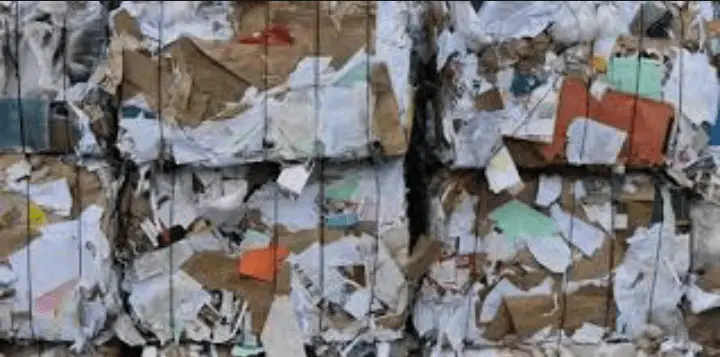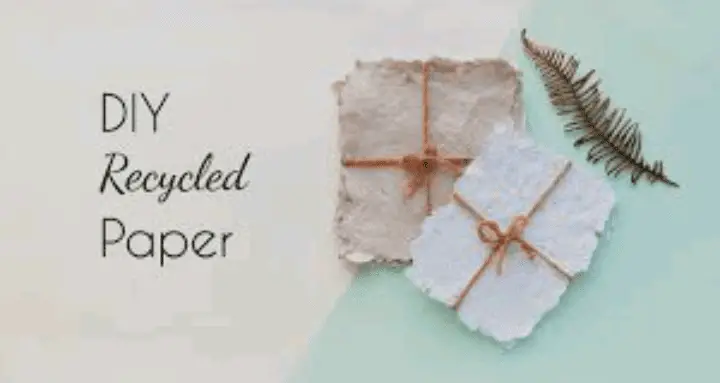The article will provide step-by-step instructions on how to convert collected paper wastes into new paper products that are usable. From sorting and shredding to the intricacies of the pulping process, we’ll break down the technical aspects into easy-to-follow guidelines.
Additionally, we’ll explore creative ways to add a personal touch to the recycled papers, turning them into unique and aesthetically pleasing products.
In our fast-paced world, the environmental impact of our daily activities is more significant than ever. One area where we can make a substantial difference is by addressing the issue of converting paper waste into new paper products.
Every year, millions of tons of paper end up in landfills, contributing to environmental degradation and resource depletion. However, there is a simple yet powerful solution at our fingertips: converting paper waste into new, usable paper products.
Understanding the various types of paper and their recyclability is crucial for effective waste management. We will delve into the importance of segregation and proper disposal methods, laying the foundation for a successful paper recycling initiative.
By the end of this guide, readers will not only be equipped with the knowledge to reduce paper waste but also inspired to embark on their waste paper recycling journey, and through these practical steps, we can collectively contribute to a more sustainable and environmentally conscious future, where waste is transformed into wealth.
Read Also: Waste to Energy Business: What You Need to Know
The Types of Recyclable Paper Wastes and their Uses

Recycling paper waste is an essential practice to reduce the environmental impact of paper production and waste disposal. Various types of paper wastes can be recycled, each with its unique characteristics and potential uses.
Here’s a detailed list along with explanations of their recycling processes and applications:
1. Mixed Paper: Mixed paper includes a variety of paper types such as office paper, magazines, catalogs, junk mail, and other household papers.
Recycling Process: After collection, mixed paper is sorted, cleaned, and then processed into recycled paper products.
Uses: Recycled mixed paper can be transformed into packaging materials, tissue paper, and even new mixed paper products.
2. Cardboard: Cardboard is a thick and rigid paper material commonly used for packaging and shipping.
Recycling Process: Cardboard is collected, sorted, and then pulped to remove contaminants. The resulting pulp is used to create new cardboard products.
Uses: Recycled cardboard is utilized to manufacture new cardboard boxes, packaging materials, and paperboard products.
3. Newspaper: Newspaper is a type of paper primarily used for printing daily news.
Recycling Process: Collected newspapers undergo de-inking and pulping processes to remove ink and contaminants. The resulting pulp is used to make recycled newsprint paper.
Uses: Recycled newspaper is commonly used for printing newspapers, flyers, and other periodicals. It can also be used for insulation material.
4. Office Paper: Office paper includes white and colored paper used in offices for printing and writing.
Recycling Process: Collected office paper is de-inked and pulped to create recycled pulp, which is then used to produce new office paper.
Uses: Recycled office paper is used to make a variety of products, including printer paper, notebooks, and stationery.
5. Magazines and Catalogs: Glossy and colorful papers used for printing magazines, catalogs, and promotional materials.
Recycling Process: Magazines and catalogs undergo a de-inking process to remove ink and are then pulped to create recycled paper pulp.
Uses: Recycled magazine and catalog paper can be used to produce new magazines, catalogs, and other printed materials.
6. Paperboard: Paperboard is a thick and rigid paper often used in packaging, such as cereal boxes and shoeboxes.
Recycling Process: Collected paperboard is pulped, and the resulting pulp is used to manufacture new paperboard products.
Uses: Recycled paperboard is commonly used for packaging materials, boxes, and cartons.
7. Kraft Paper: Kraft paper is a strong, brown paper commonly used for packaging and wrapping.
Recycling Process: Collected kraft paper is pulped, and the resulting pulp is used to produce new kraft paper products.
Uses: Recycled kraft paper is used for various packaging applications, including wrapping paper, shopping bags, and corrugated boxes.
8. Paper Packaging Materials: Includes various paper-based packaging materials, such as paper bags and food containers.
Recycling Process: Collected paper packaging materials are pulped and processed to create recycled pulp for manufacturing new packaging products.
Uses: Recycled paper packaging materials are used to produce new bags, boxes, and containers for a wide range of products.
9. Tissue Paper: Lightweight and soft paper used for tissues, napkins, and other disposable products.
Recycling Process: Tissue paper is collected, pulped, and processed to create recycled pulp, which is then used to make new tissue paper products.
Uses: Recycled tissue paper is used to manufacture tissues, napkins, and other disposable paper products.
10. Shredded Paper: Shredded paper often comes from confidential documents and sensitive materials.
Recycling Process: Shredded paper is collected and typically mixed with other paper types during the recycling process to create recycled paper products.
Uses: Recycled shredded paper can be used for various applications, including packaging materials and animal bedding.
These types of paper wastes can be recycled through established recycling programs, contributing to resource conservation, energy savings, and the reduction of landfill waste.
Understanding the diverse uses of recycled paper products, individuals and businesses can make informed choices to support a more sustainable and circular economy.
Read Also: Complete Steps in Glass Recycling Guide
How to Convert Paper Wastes into New Paper Products

Paper waste is a significant environmental concern, but with the right knowledge and initiative, we can turn this issue into an opportunity. Converting paper waste into new paper products is a practical and rewarding endeavor that not only reduces our ecological footprint but also fosters a culture of sustainability.
Here’s a comprehensive guide outlining the steps to transform paper waste into new, usable paper products;
1. Collection and Segregation: Begin by collecting paper waste from various sources, such as offices, households, and schools. Ensure proper segregation of paper types, as different papers have distinct recycling processes. Common types include newspaper, cardboard, and office paper.
2. Sorting: Thoroughly sort the collected paper according to its type and quality. Remove any contaminants, such as plastic, metal, or food residues. Clean, well-sorted paper ensures a more efficient recycling process.
3. Shredding: Once sorted, shred the paper into small, uniform pieces. Shredding increases the surface area, facilitating the subsequent pulping process. A paper shredder or industrial shredding machines can be used for this step.
4. Pulping: The shredded paper is then mixed with water to create a pulp. This process breaks down the paper fibers, turning them into a slurry. Mechanical or chemical pulping methods are employed, depending on the desired paper product.
5. De-Inking (Optional): If the goal is to produce white or high-quality paper, a de-inking process can be incorporated. This step involves removing ink and other impurities from the pulp, enhancing the paper’s appearance.
6. Forming and Pressing: The pulp is then formed into sheets on a screen or mesh conveyor belt. Excess water is pressed out, and the sheets are dried, resulting in the formation of new paper. The thickness and texture of the paper can be adjusted during this stage.
7. Cutting and Finishing: Once dried, the paper sheets are cut into the desired size and shape. Additional finishing processes, such as calendaring (smoothing the surface) or coating, can be applied to meet specific quality standards.
8. Creative Touch (Optional): To add a personal and creative touch, consider incorporating additives like flower petals, seeds, or colorants into the pulp before forming the sheets. This step not only enhances the aesthetic appeal but also promotes unique and eco-friendly paper products.
The Benefits of Converting Paper Wastes into New Paper Products
Converting paper waste into new paper products brings both environmental and economic benefits. On the environmental side, recycling paper helps save trees, reducing deforestation and preserving vital ecosystems.
It also cuts down on energy consumption and minimizes water pollution compared to making paper from raw materials. Recycling paper lessens the burden on landfills, lowering methane gas emissions and contributing to a healthier planet.
Economically, paper recycling creates job opportunities in collection, processing, and manufacturing. It reduces the demand for new raw materials, making production more cost-effective.
Businesses engaging in paper recycling often find it economical due to reduced waste disposal costs and potential revenue from selling recycled paper products.
Additionally, recycled paper products have a growing market demand as consumers increasingly prioritize eco-friendly choices. Overall, converting paper waste into new products is a win-win, benefiting both the environment and the economy.
The Uses and Benefits of Recycled New Paper Products

Recycling paper waste is a sustainable practice that helps conserve resources and reduce environmental impact. There are several innovative products that can be made from recycled paper wastes. Here’s a list along with detailed explanations of their uses:
1. Recycled Paperboard: Recycled paperboard is a thick and rigid material made from compressed layers of recycled paper.
Uses: It is commonly used for packaging boxes, cartons, and various paper-based containers. It provides a sustainable alternative to traditional paperboard and reduces the demand for virgin fiber.
2. Recycled Paper Towels: These are absorbent paper towels made from recycled paper fibers.
Uses: Recycled paper towels are suitable for household and commercial use, offering a sustainable option for cleaning spills, drying hands, and general cleaning purposes.
3. Recycled Newsprint Paper: Newsprint paper made from recycled fibers, typically used in newspapers and other publications.
Uses: Suitable for printing newspapers, flyers, and other periodicals, providing an eco-friendly alternative to traditional newsprint.
4. Recycled Craft Paper: Craft paper produced from recycled fibers, available in various thicknesses and colors.
Uses: Ideal for artistic and craft projects, such as drawing, painting, and DIY activities. It is also commonly used for gift wrapping.
5. Recycled Cardboard Furniture: Sturdy and durable furniture made from recycled cardboard, often treated for increased strength.
Uses: Cardboard furniture provides an eco-friendly and cost-effective option for temporary or lightweight furniture needs, such as event displays, trade shows, or even home furnishings.
6. Recycled Paper Insulation: Insulation material made from recycled paper fibers treated for fire resistance.
Uses: Used in construction for insulating walls and ceilings. It provides an eco-friendly alternative to traditional insulation materials and helps in maintaining energy efficiency in buildings.
7. Recycled Paper Notebooks: Notebooks made from recycled paper for writing, sketching, or note-taking.
Uses: Suitable for students, professionals, and artists who prefer sustainable and environmentally friendly stationery products.
8. Recycled Paper-based Packaging Material: Innovative packaging materials made from recycled paper, designed to replace traditional plastic packaging.
Uses: Used in the packaging of various products, reducing the environmental impact of packaging waste and promoting sustainable practices in the retail industry.
9. Recycled Paper Pulp Planters: Biodegradable plant pots made from recycled paper pulp.
Uses: Ideal for starting seedlings or small plants. Once the plants grow, the entire pot can be planted directly into the soil, eliminating the need for plastic pots.
10. Recycled Paper Countertops: Durable countertops made from layers of recycled paper and a resin binder.
Uses: Used in kitchens and bathrooms as a sustainable alternative to traditional countertop materials, providing a unique and eco-friendly design option.
These products showcase the versatility of recycled paper wastes and contribute to a more sustainable and circular economy. Adopting and supporting these products can have a positive impact on the environment by reducing the demand for virgin materials and minimizing waste.
The Challenges of Converting Paper Wastes into New Paper Products and their Solutions
Challenges in converting paper waste into new products include contamination issues when paper isn’t properly sorted, and the high energy consumption in industrial-scale processes. Additionally, raising awareness and promoting participation poses a challenge for community-based recycling initiatives.
Solutions involve improved waste sorting at the source, ensuring only clean paper reaches recycling facilities. Technological advancements in industrial processes can enhance energy efficiency.
Education campaigns are crucial for fostering public understanding and participation. Communities can establish accessible recycling centers and incentivize participation through rewards or recognition.
Collaboration between governments, businesses, and communities is key to developing comprehensive solutions that address both individual and large-scale challenges, promoting a more sustainable and effective approach to converting paper waste into valuable new products.
Frequently Asked Questions (FAQ’s) on How to Convert Paper Wastes into New Paper Products
Q1: Why should I bother recycling paper?
A: Recycling paper helps save trees, conserves energy, reduces pollution, and minimizes landfill waste, contributing to a healthier environment.
Q2: Can I recycle all types of paper?
A: Generally, yes. Newspapers, magazines, office paper, and cardboard are all recyclable. Avoid papers contaminated with food, grease, or non-paper materials.
Q3: How can I recycle paper at home?
A: Start by collecting paper waste, shred or tear it, soak in water, blend to create pulp, then form, press, and dry your paper. It’s a simple DIY process!
Q4: What’s the environmental impact of paper recycling?
A: Paper recycling reduces deforestation, energy consumption, and water pollution. It lessens greenhouse gas emissions and promotes a more sustainable use of resources.
Q5: Can I recycle paper with ink or print on it?
A: Yes, most recycling processes can handle paper with ink. In industrial settings, de-inking processes are often used to remove ink and contaminants.
Q6: What challenges are faced in paper recycling?
A: Challenges include contamination issues due to improper sorting, energy consumption in industrial processes, and the need for increased awareness and participation.
Q7: How can communities promote paper recycling?
A: Communities can set up accessible recycling centers, conduct education campaigns, and provide incentives for recycling to encourage widespread participation.
Q8: What types of new paper products can be made from recycled paper?
A: Recycled paper can be used to make various products like stationery, cardboard, tissue, and packaging materials. The possibilities are diverse and eco-friendly.
Q9: Is paper recycling economically beneficial?
A: Yes, it creates job opportunities, reduces production costs, and lowers waste disposal expenses for businesses. The growing market demand for eco-friendly products also adds economic value.
Q10: Can I combine different types of paper in recycling?
A: It’s best to separate paper types for efficient recycling. Mixing different papers can result in lower-quality recycled products. Sort them into categories like newspaper, cardboard, and office paper for better results.
Read Also: 20 Medicinal Health Benefits Of Haematoxylum campechianum (Logwood)

